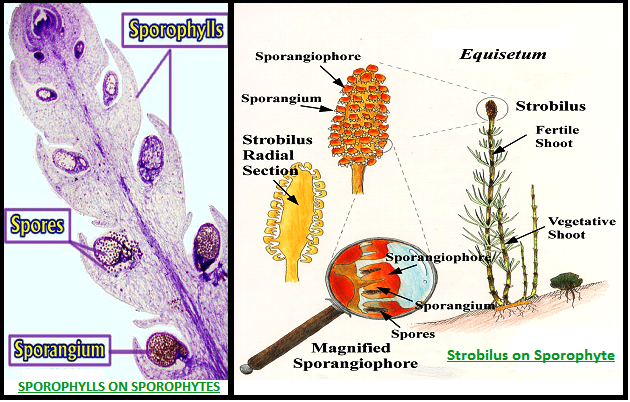`star` `color{Violet}"Sporophyte"`:
● In pteridophytes, the main plant body is a sporophyte which is differentiated into true root, stem and leaves. These organs possess well-differentiated vascular tissues.
● The leaves in pteridophyta are small (`color{Green}"microphylls"`) as in 𝘚𝘦𝘭𝘢𝘨𝘪𝘯𝘦𝘭𝘭𝘢 or large (`color{Green}"macrophylls"`) as in ferns.
●At maturity, the sporophytes bear sporangia that are subtended by leaf-like appendages called `color{Green}"sporophylls"`. In some cases sporophylls may form distinct compact structures called `color{Green}"strobili or cones"` (𝘚𝘦𝘭𝘢𝘨𝘪𝘯𝘦𝘭𝘭𝘢, 𝘌𝘲𝘶𝘪𝘴𝘦𝘵𝘶𝘮). The sporangia produce spores by meiosis in spore mother cells.

`star` `color{Violet}"Spores"`:
● In majority of the pteridophytes all the spores are of similar kinds; such plants are called `color{Green}"homosporous"` as in 𝘋𝘳𝘺𝘰𝘱𝘵𝘦𝘳𝘪𝘴.
● Genera like 𝘚𝘦𝘭𝘢𝘨𝘪𝘯𝘦𝘭𝘭𝘢 and 𝘚𝘢𝘭𝘷𝘪𝘯𝘪𝘢 produce two kinds of spores, macro (large) and micro (small) spores, and are known as `color{Green}"heterosporous"`.
● The homospores give rise to monoecious species and the heterospores (megaspores and microspores) germinate and give rise to dioecious species with female and male gametophytes, respectively.

`star` `color{Violet}"Gametophyte"`:
●The spores germinate to give rise to inconspicuous, small but multicellular, free-living, mostly photosynthetic, thalloid gametophytes called `color{Green}"prothallus"`.
●These gametophytes require cool, damp, shady places to grow. Because of this specific restricted requirement and the need for water for fertilisation, the spread of living pteridophytes is limited and restricted to `color{Green}"narrow geographical regions"`.
● The gametophytes bear male and female sex organs called `color{Green}"antheridia and archegonia"`, respectively.
●The female gametophytes in these plants are retained on the parent sporophytes for variable periods.
●The development of the zygotes into young embryos takes place within the female gametophytes. This event is a `color{Green}"precursor to the seed habit"` considered an important step in evolution.
● Water is required for transfer of antherozoids – the male gametes released from the antheridia, to the mouth of archegonium.
●Fusion of male gamete with the egg present in the archegonium result in the formation of zygote.
●Zygote thereafter produces a multicellular well-differentiated sporophyte which is the dominant phase of the pteridophytes.

`star` `color{Violet}"Sporophyte"`:
● In pteridophytes, the main plant body is a sporophyte which is differentiated into true root, stem and leaves. These organs possess well-differentiated vascular tissues.
● The leaves in pteridophyta are small (`color{Green}"microphylls"`) as in 𝘚𝘦𝘭𝘢𝘨𝘪𝘯𝘦𝘭𝘭𝘢 or large (`color{Green}"macrophylls"`) as in ferns.
●At maturity, the sporophytes bear sporangia that are subtended by leaf-like appendages called `color{Green}"sporophylls"`. In some cases sporophylls may form distinct compact structures called `color{Green}"strobili or cones"` (𝘚𝘦𝘭𝘢𝘨𝘪𝘯𝘦𝘭𝘭𝘢, 𝘌𝘲𝘶𝘪𝘴𝘦𝘵𝘶𝘮). The sporangia produce spores by meiosis in spore mother cells.

`star` `color{Violet}"Spores"`:
● In majority of the pteridophytes all the spores are of similar kinds; such plants are called `color{Green}"homosporous"` as in 𝘋𝘳𝘺𝘰𝘱𝘵𝘦𝘳𝘪𝘴.
● Genera like 𝘚𝘦𝘭𝘢𝘨𝘪𝘯𝘦𝘭𝘭𝘢 and 𝘚𝘢𝘭𝘷𝘪𝘯𝘪𝘢 produce two kinds of spores, macro (large) and micro (small) spores, and are known as `color{Green}"heterosporous"`.
● The homospores give rise to monoecious species and the heterospores (megaspores and microspores) germinate and give rise to dioecious species with female and male gametophytes, respectively.

`star` `color{Violet}"Gametophyte"`:
●The spores germinate to give rise to inconspicuous, small but multicellular, free-living, mostly photosynthetic, thalloid gametophytes called `color{Green}"prothallus"`.
●These gametophytes require cool, damp, shady places to grow. Because of this specific restricted requirement and the need for water for fertilisation, the spread of living pteridophytes is limited and restricted to `color{Green}"narrow geographical regions"`.
● The gametophytes bear male and female sex organs called `color{Green}"antheridia and archegonia"`, respectively.
●The female gametophytes in these plants are retained on the parent sporophytes for variable periods.
●The development of the zygotes into young embryos takes place within the female gametophytes. This event is a `color{Green}"precursor to the seed habit"` considered an important step in evolution.
● Water is required for transfer of antherozoids – the male gametes released from the antheridia, to the mouth of archegonium.
●Fusion of male gamete with the egg present in the archegonium result in the formation of zygote.
●Zygote thereafter produces a multicellular well-differentiated sporophyte which is the dominant phase of the pteridophytes.






